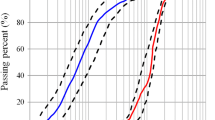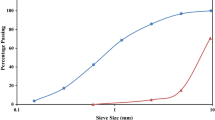Abstract
In the present study, the compressive strength, thermal properties and microstructure of self-compacting concrete with different amounts of CuO nanoparticles have been investigated. CuO nanoparticles with an average particle size of 15 nm were added to self-compacting concrete and various properties of the specimens were measured. The results indicate that CuO nanoparticles are able to improve the compressive strength of self-compacting concrete and reverse the negative effects of superplasticizer on compressive strength of the specimens. CuO nanoparticles as a partial replacement of cement up to 4 wt.% could accelerate C–S–H gel formation as a result of the increased crystalline Ca(OH)2 amount at the early ages of hydration. Increasing CuO nanoparticle content to more than 4 wt.%, causes reduced compressive strength because of unsuitable dispersion of nanoparticles in the concrete matrix. Accelerated peak appearance in conduction calorimetry tests, more weight loss in thermogravimetric analysis and more rapid appearance of peaks related to hydrated products in X-ray diffraction results, all indicate that CuO nanoparticles up to 4 wt.% could improve the mechanical and physical properties of the specimens. Finally, CuO nanoparticles improved the pore structure of concrete and caused shifting of the distributed pores from harmless to low harm.
Similar content being viewed by others
Change history
02 December 2022
This article has been retracted. Please see the Retraction Notice for more detail: https://doi.org/10.1007/s12046-022-02043-6
References
Abell A B, Willis K L and Lange D A 1999 Mercury Intrusion Porosimetry and Image nalysis of Cement-Based Materials, J. Colloid Interface Sci. 211: 39–44
Baierlein R 2003 Thermal physics. Cambridge University Press. ISBN 0-521-658381
Bjornstrom J, Martinelli A, Matic A, Borjesson L and Panas I 2004 Accelerating effects of colloidal nano-silica for beneficial calcium–silicate–hydrate formation in cement, Chem. Phys. Lett. 392(1–3): 242–248
Bosiljkov V B 2003 SCC mixes with poorly graded aggregate and high volume of limestone filler, Cem. Concr. Res. 33(9): 1279–1286
Campillo I, Guerrero A, Dolado J S, Porro A, Ibáñez J A and Goñi S 2007 Improvement of initial mechanical strength by nanoalumina in belite cements, Mater. Lett. 61: 1889–1892
Chopin D, Francy O, Lebourgeois S and Rougeau P 2003 ‘Aleep and shrinkage of heat-cured self compacting concrete (SCC)’, In: O Wallevik and I Nielsson, (eds.), Proceedings of the 3rd international RILEM symposium on self-compacting concrete, RILEM Publications S.A.R.L., Reykjavik, 672–683
Daoud A, Lorrain M and Laborderie C 2003 ‘Anchorage and cracking behaviour of self-compacting concrete’, In: O Wallevik and I Nielsson, (eds.) Proceedings of the 3rd international RILEM symposium on self compacting concrete, RILEM Publications S.A.R.L., Reykjavik, 692–702
Fava C, Bergol L, Fornasier G, Giangrasso F and Rocco C 2003 ‘Fracture behaviour of self–compacting concrete’, In: O Wallevik and I Nielsson, (eds.) Proceedings of the 3rd international RILEM symposium on self-compacting concrete, RILEM Publications S.A.R.L., Reykjavik, 628–636
Fernandez E, Gil F J, Ginebra M P, Driessens F C M, Planell J A and Best S M 1999 ‘Production and characterisation of new calcium phosphate bone cements in the CaHPO4-a-Ca3(PO4)2 system: pH, workability and setting times’, J. Mater. Sci. Mater. Med. 10: 223–230
Flores-Velez L M and Dominguez O 2002 ‘Characterization and properties of Portland cement composites incorporating zinc-iron oxide nanoparticles’, J. Mater. Sci. 37: 983–988
Grzeszczyk S and Lipowski G 1997 ‘Effect of content and particle size distribution of high calcium fly ash on the rheological properties of cement pastes’, Cem. Concr. Res. 27(6): 907–916
Hammer T A, Johansen K and Bjøntegaard Ø 2001 ‘Volume changes as driving forces to self-induced cracking of norwegian SCC’, In: K Ozawa and M Ouchi, (eds.) Proceedings of the 2nd international RILEM symposium on self-compacting concrete, Published by COMS Engineering Corporation, Tokyo, 423–432
Hauke B 2001 ‘Self-compacting concrete for precast concrete products in Germany’, In: K Ozawa and M Ouchi, (eds.) Proceedings of the 2nd international RILEM symposium on self-compacting concrete, Published by COMS Engineering Corporation, Tokyo, 633–642
Jawed J, Skalny J and Young J F 1983 ‘Hydration of Portland Cement. Structure and Performance of Cements, P Barnes (ed.)’, Essex: Applied Science Publishers, 284–285
Ji T 2005 ‘Preliminary study on the water permeability and microstructure of concrete incorporating nano-SiO2’, Cem. Concr. Res. 35(10): 1943–1947
Jo B-W, Kim C-H, Tae G-h and Park J-B 2007 ‘Characteristics of cement mortar with nano-SiO2 particles’, Construct. Build. Mater. 21(6): 1351–1355
Klug Y and Holschemacher K 2003 ‘Comparison of the hardened properties of self-compacting and normal vibrated concrete’, In: O Wallevik and I Nielsson, (eds.) Proceedings of the 3rd international RILEM symposium on self-compacting concrete, RILEM Publications S.A.R.L., Reykjavik, 596–605
Köning G, Holsechemacher K, Dehn F and Weiβe D 2001 ‘Self-compacting concrete-time development of material properties and bond behavior’, In: K Ozawa and M Ouchi, (eds.) Proceedings of the 2nd international RILEM symposium on self-compacting concrete, Published by COMS Engineering Corporation, Tokyo, 507–516
Li H, Xiao H and Ou J 2004 ‘A study on mechanical and pressure-sensitive properties of cement mortar with nanophase materials’, Cement and Concrete Res. 34: 435–438
Li H, Zhang M and Ou J 2007 ‘Flexural fatigue performance of concrete containing nanoparticles for pavement’, Int. J. Fatigue, 29: 1292–1301
Li Z, Wang H, He S, Lu Y and Wang M 2006 ‘Investigations on the preparation and mechanical properties of the nano-alumina reinforced cement composite’, Mater. Lett. 60: 356–359
Lin Y H, Tyan Y Y, Chang T P, Chang C Y 2004 An assessment of optimal mixture for concrete made with recycled concrete aggregates. Cem. Concr. Res. 34(8): 1373–1380
Lu P, Young J F 1992 Hot pressed DSP cement paste, Material Res. Soc. Symposium Proceedings, 245
Makishima O, Tanaka H, Itoh Y, Komada K and Satoh F 2001 ‘Evaluation of mechanical properties and durability of super quality concrete’, In: K Ozawa and M Ouchi, (eds.) Proceedings of the 2nd international RILEM symposium on self-compacting concrete, Published by COMS Engineering Corporation, Tokyo, 475–482
Massazza F 1987 ‘The role of the additions to cement in the concrete durability’, Cemento 84: 359–382
Müller I 2007 A history of thermodynamics - The doctrine of energy and entropy. Springer. ISBN 978-3-540-46226-2
Nazari A 2010 The effects of curing medium on flexural strength and water permeability of concrete incorporating TiO2 nanoparticles, Mater. Struct. doi:10.1617/s11527-010-9664-y
Nazari A, Riahi S 2010a Microstructural, thermal, physical and mechanical behavior of the self compacting concrete containing SiO2 nanoparticles, Mater. Sci. Eng. A 527: 7663–7672
Nazari A, Riahi S 2010b The effects of TiO2 nanoparticles on flexural damage of self-compacting concrete, Int. J. Damage Mech. doi:10.1177/1056789510385262
Nazari A, Riahi S 2010c The effect of TiO2 nanoparticles on water permeability and thermal and mechanical properties of high strength self-compacting concrete, Mater. Sci. Eng. A. doi:10.1016/j.msea.2010.09.074
Nazari A, Riahi S 2010d The effects of zinc dioxide nanoparticles on flexural strength of self-compacting concrete, Composites Part B: Engineering, doi:10.1016/j.compositesb.2010.09.001
Nazari A, Riahi S 2010e The effects of ZnO2 nanoparticles on split tensile strength of self-compacting concrete, J. Exp. Nanoscience. doi:10.1080/17458080.2010.524669
Nazari A, Riahi S 2010f Limewater effects on properties of ZrO2 nanoparticle blended cementitious composite, J. Compos. Mater. doi:10.1177/0021998310376118
Nazari A, Riahi S 2010g Assessment of the effects of Fe2O3 nanoparticles on water permeability, workability, and setting time of concrete, J. Compos. Mater. doi:10.1177/0021998310377945
Nazari A, Riahi S 2010h he effects of limewater on flexural strength and water permeability of Al2O3 nanoparticles binary blended concrete, J. Compos. Mater. doi:10.1177/0021998310378907
Nazari A, Riahi S 2010i The effects of limewater on split tensile strength and workability of Al2O3 nanoparticles binary blended concrete, J. Compos. Mater. doi:10.1177/0021998310378909
Nazari A, Riahi S 2010j The effects of TiO2 nanoparticles on properties of binary blended concrete, J. Compos. Mater. doi:10.1177/0021998310378910
Nazari A, Riahi S 2010k Optimization mechanical properties of Cr2O3 nanoparticle binary blended cementitious composite, J. Compos. Mater. doi:10.1177/0021998310377944
Porter D A and Easterling K E 1992 Phase Transformation in Metals and Alloys, 2nd ed. London: Chapman Hall
Puertas F, Santos H, Palacios M and Martínez-Ramírez S 2005a ‘Polycarboxylate superplasticiser admixtures: effect on hydration, microstructure and rheological behavior’, Advances in Cement Res. 17(2): 77–89
Puertas F, Alonso M M and Vázquez T 2005b ‘Effect of polycarboxylate admixtures on portland cement paste setting and rheological behavior’, Materiales de Construcción 55(277): 61–73
Roncero J and Gettu R 2002 ‘Influencia de los superplastificantes en la microestructura de la pasta hidratada y en el comportamiento diferido de los morteros de cement’, Cemento Hormigón 832: 12–28
Song H W, Byun K J, Kim S H and Choi D H 2001 ‘Early-age creep and shrinkage in self-compacting concrete incorporating GGBFS’, In: K Ozawa and M Ouchi, (eds.) Proceedings of the 2nd international RILEM symposium on self-compacting concrete, Published by COMS Engineering Corporation, Tokyo, 413–422
Su N, Hsu K and Chai H 2001 ‘A simple mix design method for self-compacting concrete’, Cement and Concrete Res. 31(12):1799–1807
Tanaka K and Kurumisawa K 2002 ‘Development of technique for observing pores in hardened cement paste’, Cement and Concrete Res. 32: 1435–1441
Wu Z W and Lian H Z 1999 ‘High performance concrete’, Beijing: Railway Press of China, 43
Ye Q 2001 ‘The study and development of the nano-composite cement structure materials’, New Building Materials, 1: 4–6
Ye G, Xiu X, De Schutter G, Poppe A M, Taerwe L 2007 Influence of limestone powder as filler in SCC on hydration and microstructure of cement pastes, Cem. Concr. Compos. 29(2): 94–102
Zivica V 2009 ‘Effects of the very low water/cement ratio’, Constr. Build. Mater. 23(8): 2846–2850
Author information
Authors and Affiliations
Corresponding author
Additional information
This article has been retracted. Please see the retraction notice for more detail:https://doi.org/10.1007/s12046-022-02043-6
About this article
Cite this article
NAZARI, A., RIAHI, S. RETRACTED ARTICLE: Effects of CuO nanoparticles on compressive strength of self-compacting concrete. Sādhanā 36, 371–391 (2011). https://doi.org/10.1007/s12046-011-0023-7
Received:
Revised:
Accepted:
Published:
Issue Date:
DOI: https://doi.org/10.1007/s12046-011-0023-7




